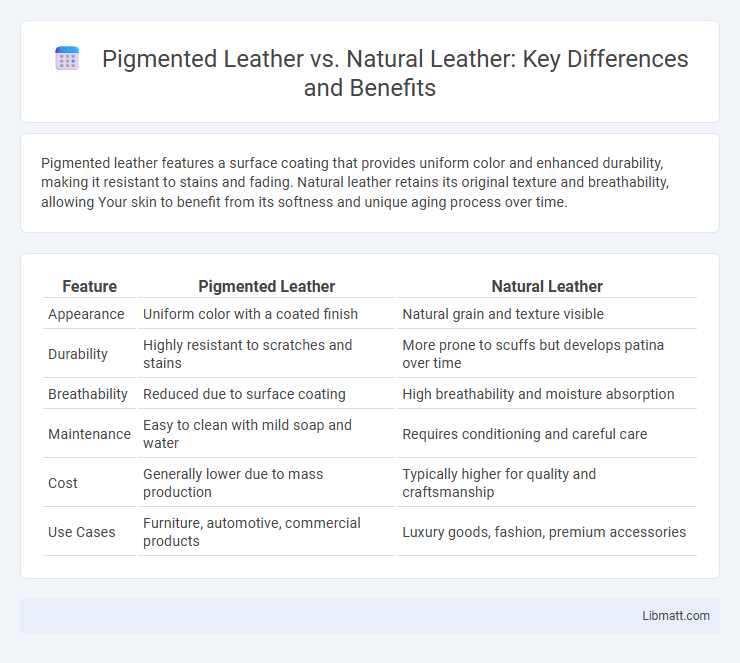Pigmented leather features a surface coating that provides uniform color and enhanced durability, making it resistant to stains and fading. Natural leather retains its original texture and breathability, allowing Your skin to benefit from its softness and unique aging process over time.
Table of Comparison
| Feature | Pigmented Leather | Natural Leather |
|---|---|---|
| Appearance | Uniform color with a coated finish | Natural grain and texture visible |
| Durability | Highly resistant to scratches and stains | More prone to scuffs but develops patina over time |
| Breathability | Reduced due to surface coating | High breathability and moisture absorption |
| Maintenance | Easy to clean with mild soap and water | Requires conditioning and careful care |
| Cost | Generally lower due to mass production | Typically higher for quality and craftsmanship |
| Use Cases | Furniture, automotive, commercial products | Luxury goods, fashion, premium accessories |
Introduction to Pigmented and Natural Leather
Pigmented leather features a protective coating that enhances durability and color consistency, making it ideal for high-use furniture and automotive applications. Natural leather preserves the original grain and texture, offering a breathable, soft surface that develops a unique patina over time. Both types cater to different preferences, balancing aesthetics, maintenance, and longevity in leather products.
What is Pigmented Leather?
Pigmented leather is leather coated with a uniform layer of pigment and clear finish, creating a consistent color and improved durability. This type of leather offers enhanced resistance to stains, fading, and wear compared to natural leather, making it ideal for high-traffic applications like furniture and automotive upholstery. The pigmented coating masks natural imperfections, resulting in a more uniform appearance while slightly reducing the leather's breathability.
What is Natural Leather?
Natural leather is derived directly from the animal hide and maintains its original texture, breathability, and unique markings, which result from the natural grain patterns and pores. Unlike pigmented leather, which is coated with a layer of paint or pigment to create a uniform color and finish, natural leather preserves its organic qualities, including its ability to age and develop a rich patina over time. This type of leather is prized for its durability, softness, and authentic characteristics that reflect the animal's natural skin.
Manufacturing Process: Pigmented vs Natural Leather
Pigmented leather undergoes a manufacturing process where a protective coating, typically containing pigments and polymers, is applied to the leather surface to enhance durability and uniform color. Natural leather is tanned and finished with minimal surface treatment, preserving its original texture and allowing natural markings to show through. The pigmented leather process involves additional steps like spraying or embossing the coating, while natural leather relies on traditional tanning and light finishing techniques.
Appearance and Aesthetic Differences
Pigmented leather features a uniform, consistent surface with vibrant color options due to its top-layer coating, making it ideal for achieving specific design aesthetics. Natural leather retains visible grain patterns, scars, and variations, providing a rich, authentic, and unique appearance that evolves with age. The inherent imperfections in natural leather enhance its character, while pigmented leather offers a smoother, more polished look.
Durability and Wear Resistance
Pigmented leather features a protective coating that enhances durability and wear resistance, making it less prone to scratches and fading over time. Natural leather, while offering a softer feel and unique aging characteristics, may show signs of wear more quickly due to its untreated surface. You'll find pigmented leather ideal for applications requiring long-lasting performance and easy maintenance.
Maintenance and Care Requirements
Pigmented leather features a durable protective coating that resists stains and requires minimal cleaning, making it easier to maintain with regular dusting and occasional wiping using mild soap and water. Natural leather lacks a protective pigment layer, necessitating more intensive care such as conditioning with specialized leather creams to prevent drying, cracking, and fading from exposure to sunlight and moisture. Proper maintenance of natural leather extends its lifespan but demands consistent attention to preserve its suppleness and natural patina.
Cost Comparison
Pigmented leather generally costs less than natural leather due to its surface coating process, which requires fewer high-grade hides and less labor-intensive finishing. Natural leather involves more complex tanning and finishing techniques to preserve its organic texture and durability, driving up production expenses. The price difference reflects pigmented leather's mass production economics versus natural leather's premium quality and longer lifespan.
Best Uses for Pigmented Leather
Pigmented leather offers superior durability and resistance to stains, making it ideal for high-traffic furniture, automotive interiors, and commercial seating where wear and tear are frequent. Its uniform color and protective coating ensure minimal maintenance, preserving appearance even in environments exposed to sunlight and moisture. Choosing pigmented leather for your upholstery provides a practical balance of aesthetic consistency and long-lasting performance.
Best Uses for Natural Leather
Natural leather excels in applications requiring durability, breathability, and a luxurious feel, such as high-end furniture upholstery, premium footwear, and bespoke leather apparel. Its porous surface allows for better moisture absorption, making it ideal for products where comfort and longevity are prioritized. Customizable finishes and natural aging characteristics also enhance its appeal for artisanal leather goods and vintage-style accessories.
Pigmented leather vs natural leather Infographic

 libmatt.com
libmatt.com